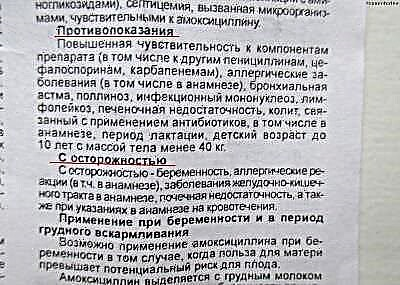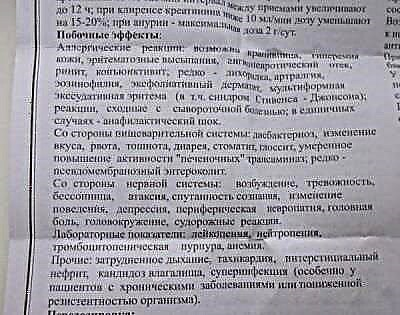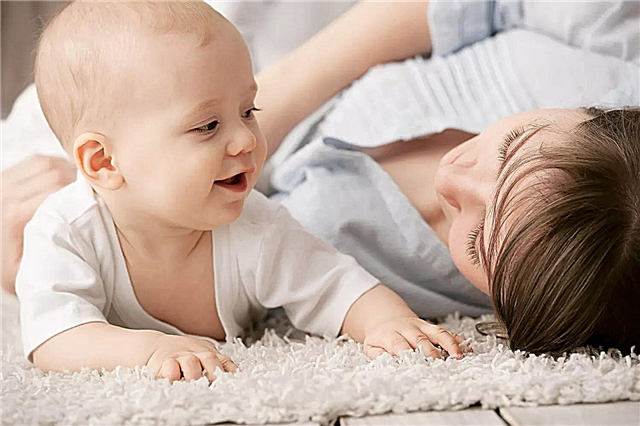
Penicillin antibiotics are widely used in the treatment of bacterial infections in childhood. One of the most popular is Amoxicillin. Pediatricians often prescribe it to children, but many mothers doubt whether it is worth using it and whether it is possible to give this medication before the age of one year, for example, to a month-old baby. Also, parents are often interested in how to dilute such a medicine and in what dose it can be given to children.

Release form
There are such forms of Amoxicillin:
- Granules. They are sold in dark glass bottles weighing 40 g. Each such bottle contains a white-yellow or white powder in such an amount that, after adding water, a suspension in a volume of 100 ml is obtained. This yellowish fruity sweet potion is easily dispensed with the included measuring spoon. A full spoon holds 5 ml of liquid medicine, from which the sick child receives 250 mg of the active ingredient. Inside the spoon, you can also notice the risk, by typing a suspension to which you receive a half dose - 2.5 ml of the drug / 125 mg of the active ingredient.
- Pills, presented as conventional tablets, and in a film shell. They are available with an active ingredient content of both 250 and 500 mg, and one pack of tablets can contain 10, 20 or more.
- Capsules. This form of Amoxicillin is represented by white-green gelatin capsules. Each of them contains a yellowish or white powder containing 250 or 500 mg of the active compound inside. One box can contain 16, 10, 20 or more capsules.
As you can see, Amoxicillin is available only in the form of drugs that are taken orally. Injections with this antibiotic are not performed.
Composition
The main substance of Amoxicillin, due to which the drug has an antimicrobial effect, is represented by amoxicillin trihydrate.
Such a compound is complemented by other ingredients that differ in different forms:
- Pills additionally contain potato starch and magnesium stearate, and if they are coated, they may additionally include titanium dioxide, talc, hypromellose and other components.

- In granules in addition to the active component, there are flavors (they give the medicine a strawberry-raspberry smell) and sweeteners (saccharin and sucrose). In addition, this form includes guar gum, Na citrate, simethicone, and Na benzoate.

- Inside capsules in addition to amoxicillin, there is microcrystalline cellulose and magnesium stearate, and gelatin and several types of dyes are used to make the capsule body.

Operating principle
Amoxicillin is one of the antibiotics included in the "penicillin" group. He has a very wide range of antimicrobial effects. The medicine acts on the walls of bacterial cells, as a result of which they are damaged and microbes die. This effect is called bactericidal.
It is noted in relation to:
- Streptococci
- Gonococcus.
- Staphylococci.
- Peptostreptococci.
- Pneumococci.
- Escherichia coli.
- Shigell.
- Salmonella.
- Klebsiell.
- Meningococcus.
- Enterococci.
- Borrelius.
- Clostridium.
- Corinebacteria.
- Chlamydia.
- Listeria.
- Proteus.
- Treponem.
- Campylobacter.
- Helicobacter.
- Fusobacteria.

Once in the patient's digestive tract, amoxicillin trihydrate is not destroyed by the acidic environment of the stomach, but rather quickly absorbed in the intestine. The maximum concentration of this compound in the blood is determined already one or two hours after ingestion.
Further, the drug penetrates well enough into mucous membranes, fluids, bronchial secretions, urine and other tissues of the body. Excretion of Amoxicillin occurs mainly by the kidneys. The drug is completely excreted in the urine within 6-8 hours.
It should also be noted that in the body part of Amoxicillin destroys an enzyme called penicillinase. In addition, not all microbes die under its influence. There are species of staphylococci and streptococci that are insensitive to Amoxicillin.
The medication is often ineffective when infected with pseudomonads, serratia, bacteroids, proteus or enterobacter. In addition, Amoxicillin does not help get rid of rickettsia or mycoplasma. This drug has no effect on viruses either, so its appointment for ARVI, influenza, viral stomatitis and colds is not justified.

Indications
Amoxicillin for children is effective for such diseases:
- With angina, otitis media and bacterial infection of other ENT organs.
- With pneumonia, tracheobronchitis, pharyngitis, bronchitis and any other infections of the respiratory system.
- With cystitis, nephritis, urethritis and other microbial lesions of the genitourinary system.
- For some intestinal infections, such as salmonellosis or dysentery.
- With leptospirosis, borreliosis, gonorrhea and listeriosis.
- With scarlet fever and other infections caused by streptococcus.
- With meningitis.
- With sepsis.
- With peritonitis or cholangitis.
- With a peptic ulcer, if its cause is the bacterium Helicobacter.

From what age is it allowed to take?
Treatment of children with Amoxicillin is allowed from birth, but for babies under 2 years old, the medicine is prescribed only by a doctor and only in cases where there is a reason for this. Up to 5 years of age, the drug is prescribed in granules, since it is more convenient for small children to give medicines in liquid form. Children over 5-6 years old can be given both a suspension and tablets. If a child swallows solid medicines well, from the age of 5, Amoxicillin can also be offered in capsules.

Contraindications
Amoxicillin should not be prescribed to a child if he is allergic to this or any other antibacterial drug of the penicillin group. An allergic reaction to cephalosporin drugs will also be a contraindication.
The restrictions under which they refuse to take Amoxicillin or use this antibiotic with caution also include:
- Kidney pathology.
- Lymphocytic leukemia.
- Liver disease.
- Pollinosis, bronchial asthma and other allergic diseases.
- Breast-feeding.
- Dysbacteriosis.
- Bleeding in the past.

Side effects
Among the possible negative symptoms with which the child's body reacts to treatment with Amoxicillin, there are:
- Allergic reactions such as hives, runny nose, or conjunctivitis. Very rarely, taking Amoxicillin can lead to anaphylaxis and other serious manifestations of allergies.
- Disorders of the digestive tract. The use of the medication often causes nausea or loose stools. Amoxicillin also has a negative effect on liver function, the ability to cause dysbiosis or enterocolitis.
- Negative changes in the nervous system. They manifest as dizziness, anxiety, bad mood, headache, insomnia, restlessness, and other symptoms. In extremely rare cases, the drug can provoke seizures.
Also, taking Amoxicillin can affect the blood test (the number of formed elements decreases), pulse rate and respiration. In addition, treatment with such a medication, although rare, leads to superinfection and candidiasis.

Instructions for use
Any form of Amoxicillin is taken orally, and since food does not in any way affect the absorption of this medication from the gastrointestinal tract, you can drink such an antibiotic both after meals and before meals. The drug is taken three times.
It is necessary to dilute the granules with water, which is previously brought to a boil and cooled to room temperature. The bottle with the powder is filled with a liquid, then it is closed and, by means of shaking, the dry substance is uniformly mixed with water. To measure the required amount of suspension for the child, use a spoon, which is sold with the bottle.
Amoxicillin tablets or capsules are suggested to the child to swallow and drink with water. The duration of treatment for different diseases will differ and can be up to 12 days. To determine it, doctors consider the disappearance of clinical symptoms to be the main criterion - from that moment the drug is given for another 2-3 days.

Dosage
- For babies in the first two years of life, a single dose of Amoxicillin is selected by weight. To calculate it, you need to multiply the body weight of the crumbs in kilograms by 20. The resulting figure will be the amount of mg of amoxicillin per dose. For example, a child at 1 year old weighs 10 kilograms, we do the calculation 10x20 and we get 200 mg of the active substance.
- Children over 2 years of age require 125 mg of amoxicillin at a time. In the specified single dose, the medicine is given up to 5 years of age. It corresponds to 2.5 ml of the drug in the form of a suspension.
- If the child is already 5 years old, the dosage of Amoxicillin per dose is increased to 250 mg, and the medicine can be given both in suspension (5 ml each), and in tablets (1 tablet each containing 250 mg of antibiotic), and in capsules (1 each capsule containing 250 mg of active compound).
- A ten-year-old child and at an older age are given Amoxicillin in a single dose of 500 mg. A child can receive so much active substance from 10 ml of suspension, as well as from two tablets or two capsules containing 250 mg of amoxicillin trihydrate. However, it is much more convenient to give at one time just 1 capsule or 1 tablet, which contains 500 mg of amoxicillin.
In some diseases, the dosage and frequency of use of Amoxicillin is changed depending on the pathogen, for example, when fighting leptospirosis or typhoid fever, the doses of the drug will be much higher, and the duration of treatment for streptococcal infections should be at least 10 days.

Overdose
Exceeding the dose of Amoxicillin usually leads to diarrhea and bouts of vomiting, and, as a result, provokes dehydration. If an overdose is detected immediately, gastric lavage is indicated, as well as the use of sorbents. Next, you need to focus on soldering with rehydration solutions in order to restore the balance of electrolytes and fluids in the child's body. In case of very severe poisoning, you need to call an ambulance.
Interaction with other drugs
- The use of antacids impairs the absorption of Amoxicillin in the intestine. The same effect has been observed with laxatives and glucosamine.
- Amoxicillin should not be combined with antibacterial drugs that have a bacteriostatic effect, for example, with macrolide antibiotics or drugs of the lincosamide group.
- The use of vitamin C improves the absorption of Amoxicillin.
- Other bactericidal drugs "work" synergistically with Amoxicillin. This interaction has been observed in cephalosporins, vancomycin, rifampicin and some other drugs.
- Due to the suppression of intestinal microflora, a decrease in the prothrombin index and inhibition of vitamin K synthesis, the use of Amoxicillin will enhance the therapeutic effect of indirect anticoagulants.
- The joint appointment of Amoxicillin and Metronidazole has a negative effect on liver function. Treatment with such a combination of medicines in childhood is contraindicated.
- During therapy with diuretics, allopurinol, nonsteroidal anti-inflammatory drugs and some other drugs, Amoxicillin will be detected in the blood at a higher concentration.

Terms of sale
To buy any form of Amoxicillin at the pharmacy, you must show a prescription from your doctor. For a bottle of granules, you need to pay about 90-100 rubles, and for a package of 20 tablets with 250 mg of active ingredient - about 30-40 rubles. The average price of a pack of 16 capsules containing amoxicillin in a dose of 250 mg is 60 rubles.
Storage conditions and shelf life
The medicine must be kept away from direct sunlight and moisture to remain effective. The optimum temperature for storing it is called the range from + 15 ° C to + 25 ° C. Children should not have free access to Amoxicillin.
An unopened package with granules has a shelf life of 3 years, but after dilution, the drug can be stored for no longer than two weeks. The shelf life of capsules is 3 years, and of tablets, depending on the manufacturer, is 2-4 years.


Reviews
Parents' impressions of the use of Amoxicillin in the treatment of their children are quite different. Many were pleased with the drug, as it quickly helped with fever and cough or with another infection. There are especially many positive reviews about the suspension, because it is easy to dose it, the taste of the medicine is pleasant, and the cost is low.
However, there are negative comments about Amoxicillin, because in some children, the drug causes allergies or digestive problems. Many mothers do not like taking such a medication three times, as well as limiting the shelf life of the finished suspension. There are also cases of ineffectiveness of Amoxicillin, when it was necessary to replace it with another antibiotic.

Analogs
Analogs with the same active compound can become a complete replacement for the drug, for example:
- Amosin. Such a drug is produced in powder for preparing a liquid medicine (suspension) and in tablets. It is also available in capsules.
- Flemoxin solutab. This medicine is a dissolving tablet.
- Ospamox. Such a drug is produced in powder and granular form (a suspension is prepared from them), as well as in capsules and several versions of tablets.
- Hikontsil. This remedy is presented in capsules as well as tablets.
- Ecobol. This antibiotic is available in tablet form.
In addition, the child can be treated with any other penicillin antibiotic (Oxacillin, Ampicillin), and an antibacterial drug from another group. The combination of amoxicillin with clavulanic acid is also considered a very effective substitute. Such components are contained in the antibiotics Augmentin, Amoxiclav, Panklav, Flemoklav Solutab, Ekoklav and others.
Due to the ability of clavulanic acid to prevent the destruction of amoxicillin by penicillinase, such drugs are more effective. And if we evaluate which is better - Amoxicillin or Amoxiclav, then we can answer that drugs with clavulanic acid are stronger than drugs containing only amoxicillin.


In the next video, the popular children's doctor Komarovsky tells what antibiotics are for and in what cases they are used.



